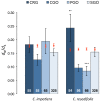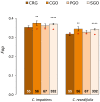Rates of evolution in stress-related genes are associated with habitat preference in two Cardamine lineages
- PMID: 22257588
- PMCID: PMC3398273
- DOI: 10.1186/1471-2148-12-7
Rates of evolution in stress-related genes are associated with habitat preference in two Cardamine lineages
Abstract
Background: Elucidating the selective and neutral forces underlying molecular evolution is fundamental to understanding the genetic basis of adaptation. Plants have evolved a suite of adaptive responses to cope with variable environmental conditions, but relatively little is known about which genes are involved in such responses. Here we studied molecular evolution on a genome-wide scale in two species of Cardamine with distinct habitat preferences: C. resedifolia, found at high altitudes, and C. impatiens, found at low altitudes. Our analyses focussed on genes that are involved in stress responses to two factors that differentiate the high- and low-altitude habitats, namely temperature and irradiation.
Results: High-throughput sequencing was used to obtain gene sequences from C. resedifolia and C. impatiens. Using the available A. thaliana gene sequences and annotation, we identified nearly 3,000 triplets of putative orthologues, including genes involved in cold response, photosynthesis or in general stress responses. By comparing estimated rates of molecular substitution, codon usage, and gene expression in these species with those of Arabidopsis, we were able to evaluate the role of positive and relaxed selection in driving the evolution of Cardamine genes. Our analyses revealed a statistically significant higher rate of molecular substitution in C. resedifolia than in C. impatiens, compatible with more efficient positive selection in the former. Conversely, the genome-wide level of selective pressure is compatible with more relaxed selection in C. impatiens. Moreover, levels of selective pressure were heterogeneous between functional classes and between species, with cold responsive genes evolving particularly fast in C. resedifolia, but not in C. impatiens.
Conclusions: Overall, our comparative genomic analyses revealed that differences in effective population size might contribute to the differences in the rate of protein evolution and in the levels of selective pressure between the C. impatiens and C. resedifolia lineages. The within-species analyses also revealed evolutionary patterns associated with habitat preference of two Cardamine species. We conclude that the selective pressures associated with the habitats typical of C. resedifolia may have caused the rapid evolution of genes involved in cold response.
Figures


Similar articles
-
Demographic History, Population Structure, and Local Adaptation in Alpine Populations of Cardamine impatiens and Cardamine resedifolia.PLoS One. 2015 May 1;10(5):e0125199. doi: 10.1371/journal.pone.0125199. eCollection 2015. PLoS One. 2015. PMID: 25933225 Free PMC article.
-
Plastome organization and evolution of chloroplast genes in Cardamine species adapted to contrasting habitats.BMC Genomics. 2015 Apr 17;16(1):306. doi: 10.1186/s12864-015-1498-0. BMC Genomics. 2015. PMID: 25887666 Free PMC article.
-
The Cardamine hirsuta genome offers insight into the evolution of morphological diversity.Nat Plants. 2016 Oct 31;2(11):16167. doi: 10.1038/nplants.2016.167. Nat Plants. 2016. PMID: 27797353 Free PMC article.
-
Molecular evolution of phytochromes in Cardamine nipponica (Brassicaceae) suggests the involvement of PHYE in local adaptation.Genetics. 2009 Jun;182(2):603-14. doi: 10.1534/genetics.109.102152. Epub 2009 Apr 10. Genetics. 2009. PMID: 19363127 Free PMC article.
-
Cardamine hirsuta: a comparative view.Curr Opin Genet Dev. 2016 Aug;39:1-7. doi: 10.1016/j.gde.2016.05.005. Epub 2016 Jun 5. Curr Opin Genet Dev. 2016. PMID: 27270046 Review.
Cited by
-
Collembolan Transcriptomes Highlight Molecular Evolution of Hexapods and Provide Clues on the Adaptation to Terrestrial Life.PLoS One. 2015 Jun 15;10(6):e0130600. doi: 10.1371/journal.pone.0130600. eCollection 2015. PLoS One. 2015. PMID: 26075903 Free PMC article.
-
Sequencing, Characterization, and Comparative Analyses of the Plastome of Caragana rosea var. rosea.Int J Mol Sci. 2018 May 9;19(5):1419. doi: 10.3390/ijms19051419. Int J Mol Sci. 2018. PMID: 29747436 Free PMC article.
-
Demographic History, Population Structure, and Local Adaptation in Alpine Populations of Cardamine impatiens and Cardamine resedifolia.PLoS One. 2015 May 1;10(5):e0125199. doi: 10.1371/journal.pone.0125199. eCollection 2015. PLoS One. 2015. PMID: 25933225 Free PMC article.
-
Evolutionary patterns of nucleotide substitution rates in plastid genomes of Quercus.Ecol Evol. 2021 Aug 30;11(19):13401-13414. doi: 10.1002/ece3.8063. eCollection 2021 Oct. Ecol Evol. 2021. PMID: 34646478 Free PMC article.
-
Phylogenetic Relationships in Orobanchaceae Inferred From Low-Copy Nuclear Genes: Consolidation of Major Clades and Identification of a Novel Position of the Non-photosynthetic Orobanche Clade Sister to All Other Parasitic Orobanchaceae.Front Plant Sci. 2019 Jul 16;10:902. doi: 10.3389/fpls.2019.00902. eCollection 2019. Front Plant Sci. 2019. PMID: 31379896 Free PMC article.
References
-
- Orr HA. The genetic theory of adaptation: a brief history. Nat Rev Genet. 2005;6:119–127. - PubMed
-
- Eckert AJ, Wegrzyn JL, Pande B, Jermstad KD, Lee JM, Liechty JD, Tearse BR, Krutovsky KV, Neale DB. Multilocus patterns of nucleotide diversity and divergence reveal positive selection at candidate genes related to cold hardiness in coastal Douglas Fir (Pseudotsuga menziesii var. menziesii) Genetics. 2009;183:289–298. doi: 10.1534/genetics.109.103895. - DOI - PMC - PubMed
Publication types
MeSH terms
Substances
LinkOut - more resources
Full Text Sources

